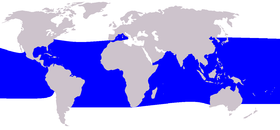Little pilot whale
| Little pilot whale | ||||||||||||
|---|---|---|---|---|---|---|---|---|---|---|---|---|

Little pilot whale ( Feresa attenuata ) |
||||||||||||
| Systematics | ||||||||||||
|
||||||||||||
| Scientific name of the genus | ||||||||||||
| Feresa | ||||||||||||
| JE Gray , 1870 | ||||||||||||
| Scientific name of the species | ||||||||||||
| Feresa attenuata | ||||||||||||
| JE Gray, 1874 |
The pygmy pilot whale ( Feresa attenuata ), also known as the pygmy killer whale or dwarf killer whale due to some common characteristics with the killer whale ( Orcinus orca ) , is a small, relatively rarely seen whale belonging to the dolphin family (Delphinidae).
Until the early 1950s, the whale was only known from two skulls in the British Museum. The first description comes from John Edward Gray from 1874. In 1954 it was rediscovered and described again by Muneasto Yamada on the basis of specimens before Honshū .
features
The pygmy pilot whale reaches a length of 2.1 to 2.6 meters and a weight of 110 to 170 kilograms. Its body is massive, especially at the front, and its head is conspicuously rounded without a protruding snout. The lips are white, and in some animals the chin too. There are 16 to 24 teeth in the upper jaw and 20 to 26 teeth in the lower jaw. The animals are dark in color with a dark brown or dark gray head and cape on the back, slightly lighter, blue-black, dark gray or brown-gray flanks and a light gray W-shape on the chest and a large white spot on the belly, which is bisected by a furrow . The body is sometimes noticeably scratched. The fin is large with a slightly pointed end and a concave, sometimes wavy rear edge. The flippers are long with rounded tips and a convex leading edge. The fluke has pointed ends and a slight indentation in the middle. Newborns are about 80 centimeters long.
distribution
The little pilot whale is native to tropical and subtropical waters around the world . It doesn't seem to be very common, however. There are regular sightings from Hawaii and Japan , and it is regularly caught as bycatch in the Indian Ocean near Sri Lanka and the Lesser Antilles . In the Atlantic, there are sightings on the coasts of Florida and Senegal . The species is stranded relatively often.
Way of life
The pygmy pilot whale forms schools of 15 to 25 animals, sometimes much larger groups. They have been observed to hunt together, killing other small whales such as the common dolphin . Their main diet, however, consists of fish and cephalopods . When in danger they form dense groups and flee. Some of the growling sounds emitted by the animals can be heard over water. In captivity, minke pilot whales have shown to be aggressive towards humans and other whales.
Systematics
The first scientific description of the pygmy pilot whale was made in 1874 by the British naturalist John Edward Gray , who classified it in the independent genus Feresa . He established this four years earlier in 1870 to classify a skull he had described as Delphinus intermedius in 1827 , Grampus intermedius in 1843 and again as Orca intermedia in 1846 , which he described as a representative of a new subgenus or a new subgenus based on a discussion with William Henry Flower already existing species of smaller whales. Feresa intermedia was later synonymous with Feresa attenuata , the dwarf pilot whale, in which case the newer name became the official species name.
|
Phylogenetic systematics of the Delphinidae according to Horreo 2018
|
Genetic studies show the pygmy killer whale as sister species of Breitschnabel Delfins ( Peponocephala Electra ) and both together as Schwestertaxon to the two types of pilot whales ( Globicephala ) Together, these species with little Orca ( Pseudorca crassidens ) and the Risso ( Grampus griseus ) the subfamily Globicephalinae within the dolphins and are compared to the two species of the genus Orcaella .
supporting documents
- ↑ a b c José L. Horreo: New insights into the phylogenetic relationships among the oceanic dolphins (Cetacea: Delphinidae). Journal of Zoological Systematics and Evolutionary Research 57 (2), May 2019; Pp. 476-480. doi : 10.1111 / jzs.12255
literature
- Mark Carwardine : Whales and Dolphins . Delius Klasing, Bielefeld 2008, ISBN 978-3-7688-2473-6 , p. 146-147 .
Web links
- Feresa attenuata in the endangered Red List species the IUCN 2006. Posted by: Cetacean Specialist Group, 1996. Retrieved on 12 May, 2006.
